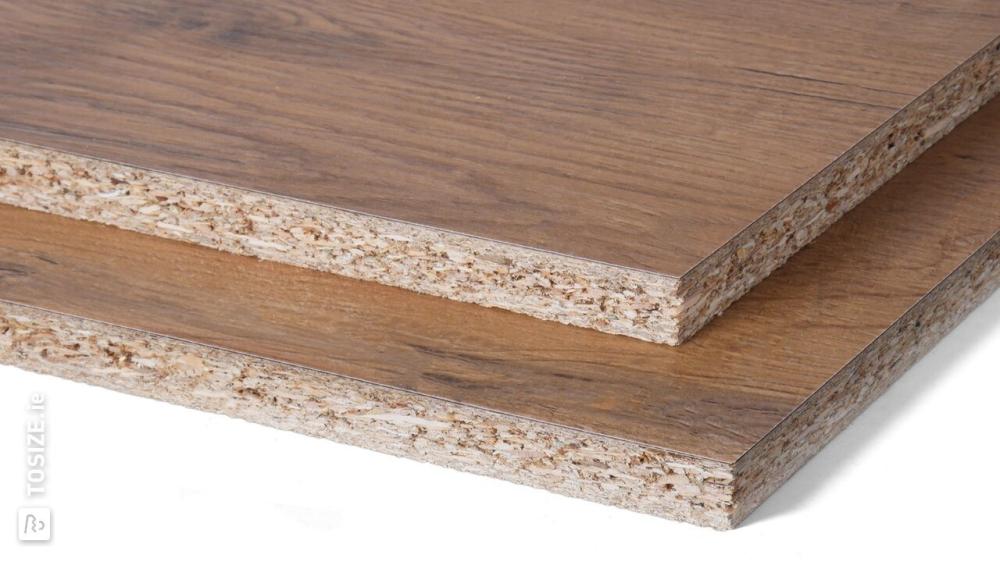In the world of furniture and interior design, a variety of materials are used to meet different needs and budgets.
Among these materials, chipboard stands out as an economical and popular choice, but its durability and quality may raise some questions.
With technological advancements, new materials have emerged that offer better benefits and are often called "chipboard alternatives."
This may raise the following question: "What is the difference between a motherboard and a motherboard alternative?" Before things get complicated, let's understand what a motherboard is and what a motherboard alternative is. We'll also highlight the differences between motherboards and motherboard alternatives , as well as explore the advantages, disadvantages, and cost of each alternative.
What is the chipboard?
Let's first understand what chipboard is. Also known as particleboard or pressed board, it's a type of manufactured wood panel.
It is produced by breaking down softwood or hardwood residues into small particles or chips, mixing them with an industrial adhesive (often urea-formaldehyde or phenolic resins) and pressing them under high heat to form a board of a specific thickness and density.
Chipboard is an economical choice because it uses recycled wood materials or industrial residuals, making it less expensive than natural wood or even some other types of manufactured wood panels.
Chipboard is widely used in the manufacture of home and office furniture, such as cabinets, shelves, and tables, especially those that require large quantities of panels at a low cost.
What is the alternative to Chipboard?
Now let's find out what is the alternative to Chipboard?
"Chipboard alternative" is a general term that refers to a variety of manufactured materials that have been developed to offer better properties than chipboard in some aspects, such as moisture resistance, durability, and appearance.
There is no single material that is exclusively known as a “chipboard alternative.” Rather, the term encompasses several types of panels and materials that can be used as a chipboard alternative in furniture and decorative applications.
The most prominent of these alternatives are:
- MDF (Medium-Density Fiberboard): Medium-density fiberboard has a smoother, more uniform surface and is more resistant to nails and screws than chipboard.
- HDF (High-Density Fiberboard): High-density fiberboard is more rigid, durable, and moisture-resistant than chipboard and MDF.
- Plywood: Consists of thin layers of wood veneer glued together, giving it good strength, stability, and better moisture resistance than chipboard.
- PVC Foam Board: Boards made from foamed polyvinyl chloride. They are lightweight and completely resistant to water, moisture, and insects, but may be less durable than other manufactured wood boards.
- WPC (Wood-Plastic Composite): A composite material composed of wood fibers and plastic, it is resistant to water, moisture, insects, and weather conditions, and is increasingly used in outdoor furniture applications and some indoor applications.
The difference between a motherboard and a motherboard alternative
The difference between a chipboard and a chipboard alternative lies in several key aspects that affect the quality, durability, and uses of each:
- Raw materials and manufacturing process: Chipboard uses larger, less homogeneous wood particles and slats, compared to MDF and HDF, which use finer fibers. Plywood uses wood veneers, while PVC and WPC rely on plastic or composite materials.
- Density and Durability: In general, chipboard alternatives such as MDF, HDF, and plywood have a higher density and better durability than chipboard, making them more resistant to bending, breaking, and load-bearing.
- Moisture resistance: This is one of chipboard's major weaknesses. Chipboard easily absorbs moisture, causing it to swell and deteriorate. Many chipboard alternatives, such as treated HDF, water-resistant plywood, PVC, and WPC, offer much better moisture resistance.
- Ability to hold nails and screws: Chipboard is less able to hold nails and screws tightly compared to MDF, HDF, and plywood due to its grain structure.
- Finish and Appearance: MDF has a smoother, more uniform surface than chipboard, making it ideal for painting and veneering. PVC and WPC come in a variety of weather-resistant finishes.
- Cost: Chipboard is usually the least expensive option, while the price of alternative chipboard varies depending on the type and quality of the material. MDF and some types of plywood may be close in price to chipboard, while HDF, PVC, and WPC may be more expensive.
Is chipboard an alternative to wood?
We also hear the term "wood alternative." Is chipboard a wood alternative?
Yes, chipboard can be considered an alternative to natural wood in many applications, especially in the manufacture of budget-friendly furniture.
Chipboard provides an economical solution for creating large, flat panels that can be cut and shaped to manufacture various pieces of furniture.
However, it's important to note that chipboard differs significantly from natural wood in its properties. Natural wood is characterized by its strength, durability, natural beauty, long lifespan, and ability to withstand heavy loads.
Chipboard, while made from wood, is less strong and durable, is sensitive to moisture, and may have a shorter lifespan. Therefore, whether chipboard is a "good" alternative to wood depends on the specific application, budget, and expectations of the final product.
Advantages of the motherboard alternative
The advantages of alternative motherboards are numerous, making them a preferred choice in some cases:
- Better Durability and Strength: Many alternatives like MDF, HDF, and plywood offer greater strength and durability than chipboard, meaning furniture that lasts longer and can withstand heavy use.
- Higher moisture resistance: Some alternatives such as treated HDF, waterproof plywood, PVC, and WPC have much better resistance to moisture and water, making them suitable for use in humid environments.
- More uniform and easier to finish surface: MDF in particular provides a smooth, flat surface that is easy to paint or veneer and melamine, resulting in a better finished appearance.
- Better nail and screw holding capacity: Higher density alternatives hold nails and screws more securely.
- Diverse options for appearance and performance: Alternatives offer a wide range of properties and appearances to meet different needs, from indoor furnishings to outdoor applications.
Disadvantages of the motherboard alternative
Despite the advantages, the disadvantages of the chipboard alternative should be taken into account:
- Higher cost: Most of the motherboard alternatives are more expensive.
- Heavier weight: Some alternatives such as MDF and HDF may be heavier than chipboard, which may affect the ease of moving the furniture.
- Some may still be sensitive to moisture: Even some engineered wood chipboard alternatives may be damaged by excessive exposure to moisture if they are not properly treated.
- Environmental considerations: The environmental impacts of producing alternative materials may vary, and some may be based on plastics.
Chipboard replacement price
The price of chipboard replacement varies greatly depending on the type of material, its quality, the thickness of the board, the manufacturer, and how wide the chipboard replacement is (although width may not be as major a factor in determining price as length and thickness).
In general, you can expect MDF to be slightly more expensive than chipboard, while HDF and mid-quality plywood are more expensive, and PVC and WPC panels may be the most expensive. To get an accurate idea of the price of a chipboard alternative , it's best to compare prices from different suppliers and determine your exact needs in terms of material type, quality, and thickness.
In conclusion, understanding the difference between chipboard and chipboard alternatives helps in making informed decisions when choosing furniture or decor .
Although chipboard remains an economical option, alternatives often offer better advantages in terms of durability, moisture resistance, and appearance.

